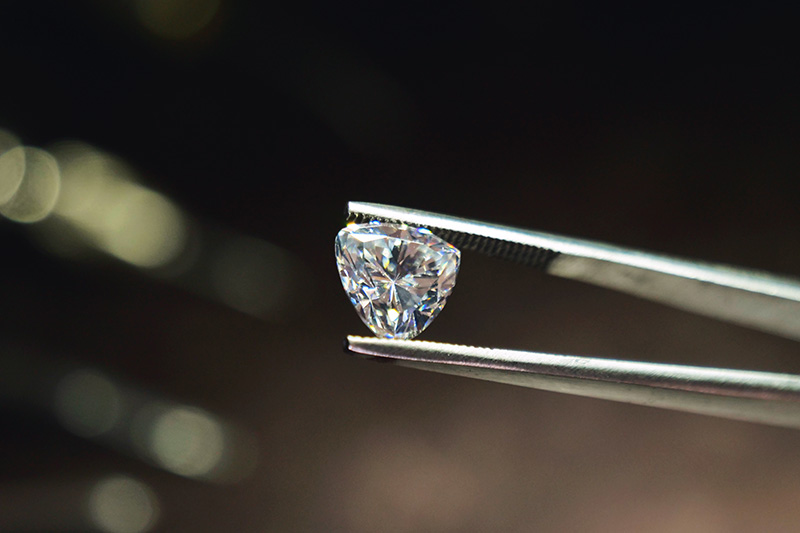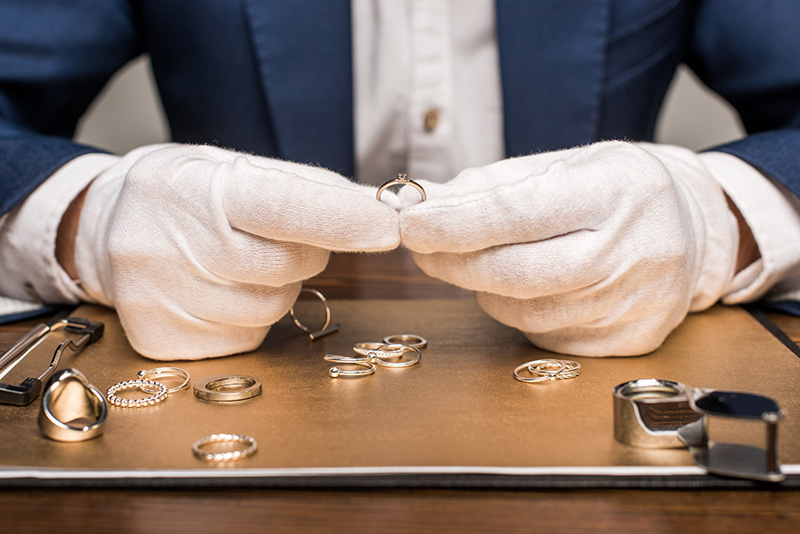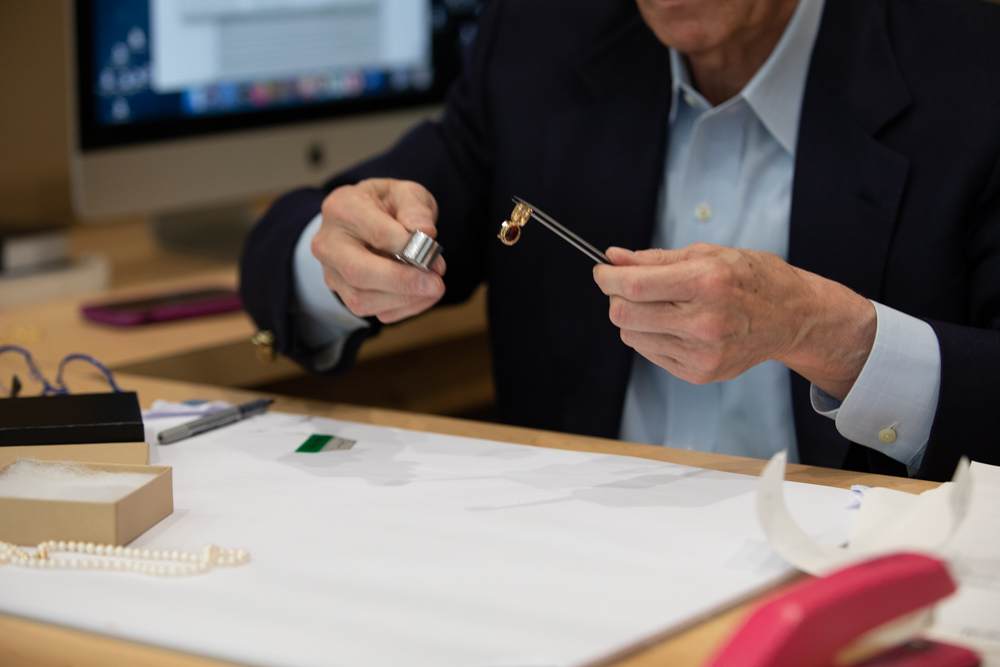

Appraisals
“I must admit I love estate jewelry and it is rare to find a jeweler with the extensive knowledge that Tom Tivol offers his clients. His eye for design and his ability to appraise rare pieces is amazing. I know for a fact his reputation as well as his keen knowledge is a rarity within the jewelry industry.” — Michelle
About Tom’s Appraisal Services
Tom appraises jewelry WHILE CLIENTS SIT WITH HIM. After departing with your jewelry, he will complete his research and mail/email the appraisal report within 1-2 days.
Tom Tivol Jewels is the premier provider of jewelry, gemstone, wrist watch, pocket watch and silver appraisal services in Kansas City. We serve individual customers, estate planning professionals and insurance agents throughout the United States. Tom Tivol himself is a Graduate Geologist in Residence from the Gemological Institute of America. All of our appraisals adhere to the highest standards of testing, laboratory equipment and appraisal methodology. Tom Tivol developed the course and teaches the Art & Science of Appraising along with his Jewelry Design and Gemology courses at the University of Kansas. Tom is an attorney whose practice revolves around the Federal Trade Commission Rules for the Jewelry Industry. He brings over 46 years of experience to the business. Mr. Tivol adheres to the code of ethics set forth by the UNIFORM STANDARDS OF PROFESSIONAL APPRAISAL PRACTICE.
“We had Tom appraisal my redding ring, and also a bunch of old pieces that we had from our parents and grandparents. He did a great job, Tom is very knowledgeable and very helpful, he is the best jeweler we now. Tom is very honest and so passionate about this industry. We would highly recommend Tom, you can trust him, and that’s very rare nowadays.” — Bella
The Process
To answer all questions not covered here, please contact us directly at (913) 489-7056, or review our MOST FREQUENTLY ASKED QUESTIONS.
To instill confidence in the public, the jewelry appraiser must have both academic training and decades of experience buying and selling jewelry and gemstones. In addition, the appraiser must master the art of appraising, which includes the study of the appraisal process, understanding the requirement of research and the ethical and legal rules governing the work product.
There are many sources for gemstones and jewelry, online and in traditional formats, in your city and on trips; however, there are very few gemstone/jewelry experts and or expert jewelry and gemstone appraisers. This suggests that the appraiser relationship is as important to the security of a family as the choice of jewelry sellers over the decades.
The public requests appraisals for many reasons. Here are the 12 most commonly requested types of appraisals, in no particular order.
1. Homeowner’s/renter’s insurance.
2. To divide jewelry equally among family members.
3. For divorce.
4. To sell online, to sell at traditional auction, to sell on consignment.
5. To receive a deduction for a charitable donation under the Internal Revenue Service rules.
6. To deduct a casualty loss under the Internal Revenue Service rules.
7. To distribute jewelry through estate planning documents.
8. As collateral for a loan.
9. To support a barter agreement.
10. To confirm the seller’s representations of price, age, gemstone origin (natural, synthetic, imitation), gemstone quality, gemstone laboratory treatments, gemstone geographic origin.
11. To identify the manufacturer, designer, hallmark.
12. To identify the chronological history of a gemstone’s price.
Fees
Products Appraised
We identify and appraise all gemstones, jewelry and family silver. Items that do not readily fit a specific category will be evaluated on a case-by-case basis. We will need to examine each unique piece to determine whether it is something we can appraise and what type of report is most appropriate to meet your needs.
Gemstones: Diamonds, colored gemstones, jade, pearls, synthetic gemstones, imitation gemstones, artificially treated gemstones, from the most common to the rarest, unmounted or set in jewelry, whether antique, modern, carved, faceted or polished.
Metals: All metals used to manufacture jewelry including pure silver, sterling silver, silver-plate, gold, gold-filled, gold-plated, the platinum family, titanium, tungsten, cobalt, rhodium, nobium, iron, brass, bronze, aluminum, and others.
Jewelry: Modern jewelry worldwide, arts and crafts jewelry, costume jewelry, estate and antique jewelry, carvings and objects of art using gemstones.
Silver: Sterling, 800 silver, silver-plate, gold leaf flatware and serving pieces manufactured in the United States, Russia and Europe, antique to modern.
Timepieces: Modern, estate, antique pocket watches, pendant watches, ring watches and wristwatches, worldwide.
Rough Gemstone Crystals: These may be identified and appraised if there is a flat polished surface available to allow proper gemological tools to be used for testing. If there is no such surface, our colored gemstone lapidaries can easily polish one, and then we may proceed with the identification.
Thorough descriptions of gemstones and jewelry protect the owner because they permit an insurance adjuster and another jeweler years later to determine current replacement value of a severely damaged or missing item. This is important whether the owner wishes to replace with a similar piece, upgrade or cash out. They are especially important if the item is missing. THEY SERVE THE ADDITIONAL PURPOSE of providing a fingerprint-like identity of gemstones and jewelry, so that the client who leaves jewelry to be repaired or modified can be assured by simple examination that they receive back what they left.
Finally, unlike reports provided by the seller, the appraiser’s job is to consider the value of gemstones and jewelry which duplicate as much as possible those in the pieces he is appraising, and available throughout a large geographic market, in order to determine a value that will protect the owner.
“I inherited a man’s 14k gold and ruby ring from my grandfather. It came with a professional looking appraisal describing the ruby and stating its value for insurance. I decided to take it to an appraiser to determine what it might be sold for currently. I went to two jewelry stores each of which advertised their appraisal service. Both appraisers confirmed that the ruby was natural, and then gave me a value they thought it was worth today. After this, I was discussing what I did with my office partner, and he recommended I go see Tom Tivol, just to make certain I was getting the correct information. I met Tom at his office in Leawood and sat with him while he examined my ruby. After a short few minutes, he determined that the ruby was not natural and in fact it was lab grown in the 1920’s. He then showed me the characteristics inside the stone that resulted in his conclusion. He also told me that many jewelers and appraisers merely assume a gemstone like this is real, because it was set in a ring several generations old, and that the first lab grown rubies appeared in the American market just after the turn of the 20th century. While the result was not what I wanted to hear, I trusted Tom‘s reputation and the process he used to identify the ruby, and realized I no longer had to pay to insure the stone. It was just part of my keepsake from my grandfather. Tom‘s gemstone expertise and patience hearing my story created the kind of trust I had been looking for in an appraiser. My wife and I from now on are going to use Tom to appraiser our jewelry, regardless of where it came from.” — Larry
Insurance Appraisals
Of all appraisals, the jewelry appraisal for the homeowner’s or renter’s insurance policy is the most frequently requested. The client presents our report to his agent who then forwards it to the underwriter. The newly insured item is then listed on a fine arts schedule which is appended to the homeowner’s policy that protects the home and its contents.
Tom performs this appraisal WHILE THE CLIENTS SIT WITH HIM. After they leave with their jewelry, he will complete his research, prepare his formal report and mail it with color photographs within 1 to 2 days.
The best insurance appraisals describe gemstones and jewelry completely, clearly and accurately, thus enabling a future jeweler and insurance adjuster to determine a proper replacement cost for a damaged or missing item. This report is an important document, similar to the legal documents that protect families and their assets. If it is written once correctly, it will never need to be re-written, only updated for current values on a regular basis.
We advise our clients to retain a copy of this report and place it and the photographs in a safe place for future reference. Please see the FAQ section for additional information.
Dividing Jewelry
For many families, dividing jewelry equally among beneficiaries is important, whether this is accomplished during your life or through estate planning documents. To give the recipients relatively equal value, the value of personal property should be stated in its cash equivalent terms. In this way, it does not matter how many items are given to one person over another, as long as the total cash value given to each person is similar. Just as you would never use cash value to insure the item, you would likewise never use the insurance value to distribute the item.
With more than 46 years of experience working in the secondhand jewelry market, Tom Tivol is an expert at determining the appropriate cash value of jewelry. To determine cash value, Tom identifies the various ways to sell jewelry and the value that may be obtained using these methods.He approaches each valuation by determining the most common market for the resale of the item in its condition, identifying a potential buyer and determining what the buyer should pay.
Resale Apprisals
If you intend to sell your jewelry on the internet (as in eBay) or to another member of the public through business or personal acquaintances, a written appraisal should accurately describe the item and help you establish its fair market value. You want your buyer to be able to take your item to their jeweler and verify your description and value.
If you intend to sell to a jewelry store, a written appraisal will not help, as all jewelers who buy from the public will have their way of analyzing the quality and gauging their interest before making an offer. You do not need the independent appraisal because it is your intention to accept the high bid, once you visit enough jewelers to perform due diligence in the process. Older appraisals you may have retained have no bearing on what a current jeweler might offer to buy your item(s).
IF YOU INTEND TO SELL VIA TRADITIONAL PUBLIC AUCTION. There are many well-known auction companies around the United States. Each has a jewelry department. To determine whether you should use an auction house, those departments must see your jewelry. An independent appraisal will not help you. The auction house must see the item and any laboratory reports you may have on the center gemstone. Some auction houses are able to give you some information after you email a photo and copies of any laboratory reports. Their final judgment however is reserved until they see each piece.
IF YOU INTEND TO RESEARCH SELLING ON CONSIGNMENT. For consignment, you do not need an independent appraisal. The jeweler who accepts jewelry on consignment will have enough knowledge of gemstones and jewelry to be able to determine what he/she believes is an acceptable resale price as well as the dollars that you would receive in the event of resale. Previous appraisals are unnecessary; however you should bring to your appointment any laboratory reports on gemstones. In 2020, there are various companies around the world that accept jewelry on consignment and there are usually jewelry stores in almost every city that accept jewelry on consignment.
CAN AN APPRAISER PURCHASE JEWELRY FROM THE PUBLIC
CAN AN APPRAISER DESIGN, SELL AND OR REPAIR JEWELRY?
CAN I WAIT WHILE MY JEWELRY IS BEING APPRAISED?
WHAT IS THE COST OF AN APPRAISAL?
HOW DOES THE APPRAISER DETERMINE THE FEE FOR EACH PIECE?
CAN I GET MY APPRAISAL UPDATED OVER THE YEARS WITHOUT TAKING THE JEWELRY TO THE APPRAISER AGAIN?
HOW OFTEN SHOULD I HAVE MY APPRAISAL UPDATED?
DO YOU REMOVE GEMSTONES TO APPRAISE?
WILL YOU UPDATE ANOTHER PERSON’S WORK?
WILL YOU APPRAISE ONLINE DESCRIPTIONS?
SHOULD ONLY EXPENSIVE JEWELRY BE APPRAISED?
DOESN’T MY HOMEOWNER’S POLICY COVER MY JEWELRY IF I DO NOT HAVE IT APPRAISED?
HOW DO YOU DETERMINE THE VALUE OF AN ITEM FOR INSURANCE?
IS THE INSURANCE VALUE THE SAME AS THE RETAIL VALUE?
CAN I TALK WITH MY APPRAISER ABOUT HOW TO SELL JEWELRY?
WHAT IS ANTIQUE VALUE? CAN VINTAGE OR PERIOD JEWELRY BE MORE EXPENSIVE BECAUSE OF ITS AGE?
WHEN I PURCHASE JEWELRY ON A TRIP, SHOULD I BRING IT TO MY APPRAISER TO EXAMINE?
CAN MY APPRAISER EXAMINE MY JEWELRY TO SEE IF ANY GEMSTONES ARE CHIPPED OR IF ANY REPAIRS ARE NEEDED?Your Title Goes Here
IS MY APPRAISAL VALUE IN ANY WAY AFFECTED BY WHETHER I HAVE PURCHASED REPLACEMENT COST COVERAGE OR AGREED VALUE (CONTRACT) COVERAGE?
IS THERE A FEE TO EXAMINE A GROUP OF PIECES JUST TO DETERMINE WHAT SHOULD AND SHOULD NOT BE APPRAISED?
I PRESUME ONE CANNOT INSURE SENTIMENTAL VALUE, RIGHT?
CAN SILVER-PLATED FLATWARE AND SERVING PIECES BE EASILY SOLD?
DO YOU APPRAISE FAMILY SILVER FLATWARE AND SERVING PIECES?
DO YOU APPRAISE SILVER FLATWARE AND SERVING PIECES IN YOUR OFFICE OR AT CLIENTS’ HOMES?
SINCE YOU RETAIN COPIES OF YOUR CLIENTS’ INSURANCE APPRAISALS, CAN I REQUEST AN APPRAISAL FOR A DIFFERENT PURPOSE AT SOME POINT IN THE FUTURE?
DO YOUR APPRAISALS COME WITH PHOTOGRAPHS?
SHOULD I BRING MY OLD APPRAISAL/LABORATORY REPORT TO MY APPOINTMENT?
WHY DO I NEED AN APPRAISAL WHEN I HAVE ONE FROM THE ORIGINAL SELLER?
IS IT IMPORTANT TO OPEN MY WATCH TO APPRAISE IT?
I HAVE A RING WITH A STONE THAT CHANGES COLOR UNDER CERTAIN LIGHTS. IS THE STONE ALEXANDRITE?
CAN YOU TELL ME HOW MUCH THE VALUE OF MY DIAMOND HAS INCREASED OVER THE PAST 25 YEARS?
IF I DONATE MY JEWELRY TO A CHARITY, CAN I DEDUCT ITS APPRAISED VALUE PROVIDED TO ME BY THE SELLER?
I PURCHASED MY DIAMOND ONLINE. WHEN YOU APPRAISE IT FOR INSURANCE, DO YOU USE INTERNET DIAMOND PRICES OR REGULAR JEWELRY STORE DIAMOND PRICES?
WHAT IS THE DIFFERENCE BETWEEN REPLACEMENT COST INSURANCE AND AGREED VALUE INSURANCE?
I KNOW THERE IS AN ONLINE COMPANY THAT SELLS JEWELRY INSURANCE. WHAT IS ITS NAME AND IS THERE AN ADVANTAGE TO USING IT OVER MY RENTER’S OR HOME OWNER’S POLICY?
CAN I HAVE MY GEMSTONE (S) IDENTIFIED BUT NOT APPRAISED?
IS MY JEWELRY INSURED IF I KEEP IT IN A SAFETY DEPOSIT BOX IN MY BANK?
HOW DOES A CHIP IN A GEMSTONE AFFECT ITS VALUE?
What Customers Are Saying
“My wife inherited a cameo pin from her great aunt. The cameo was carved from agate with 2 Roman soldiers on two horses for the raised portion of the carving. We were told to go see Tom Tivol because of his expertise in jewelry repair and because he teaches the history of gemstone and jewelry design at K.U. My wife wanted the pin changed to a pendant so she could wear it daily. Tom handled the entire process with expertise born from decades of experience repairing jewelry along with academic study of antique gemstone cameos. His detailed receipt with photos made us feel totally secure with his care of our cameo. He detailed the process of creating a pendant from the pin, and when it was finished, he presented it to us and also returned the “pin hardware” that he had removed in the process. We could not have been in better hands!” — Helen and George
“I was in the process of trying to determine how to gift my jewelry to my children and or grandchildren, as part of my estate planning documents. I was referred to Tom Tivol because of his appraisal expertise in this sensitive area of appraising fine art along with his legal background in this area. My desire was to try and give each recipient close to equal value. I met Tom at his office by appointment and sat with him while he examined my pieces. He explained the differences between retail insurance appraisals, appraisals for charitable donations, appraisals for divorce and fair market value appraisals used for many purposes, including gifting or dividing jewelry among family members. Once he identified gemstones and metals, we compared values provided for insurance with fair market value for gifting jewelry and gemstones, and Tom explained to me why fair market value is the correct standard to use for this task. I was able to depart with my jewelry, and my appraisal followed by mail a few days later. Tom is an authentic expert, having spent his life in the study of gemstones and jewelry, and even more important, he has the ability to teach his clients in a common sense fashion how to get this accomplished.” — Ola
Get In Touch!
(913) 359-6820


